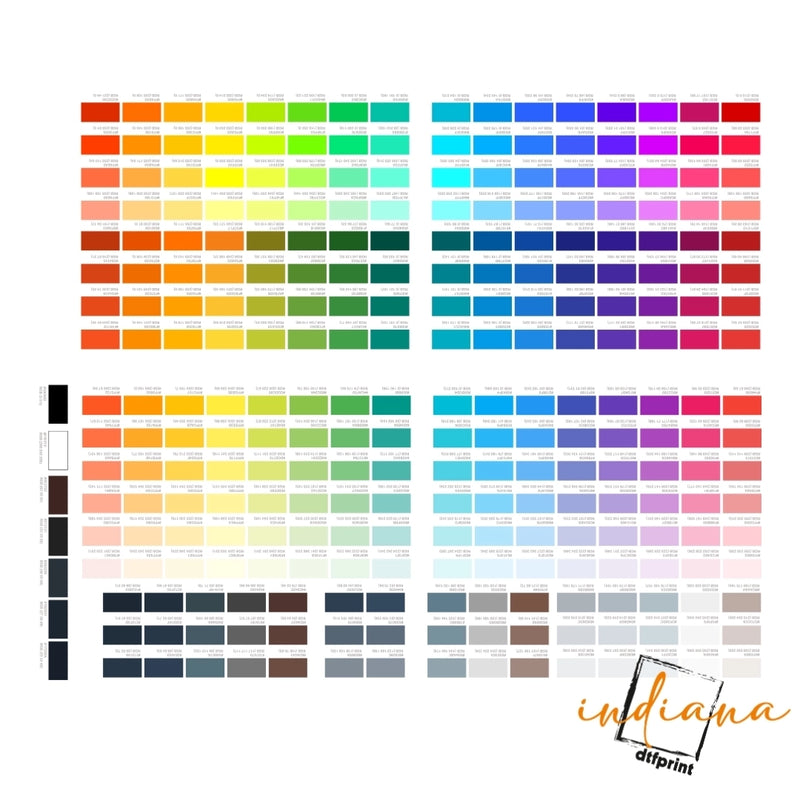Starting with a new print method can feel confusing. But don’t worry, if you’re curious about beginner DTF printing, this guide will walk you through it step by step. No jargon, no boring talk, and yes, you can read this without dozing off.
DTF (Direct-to-Film) printing has taken the apparel world by storm. It’s fast, flexible, and delivers high-quality results on different fabrics. For anyone new, this blog will explain DTF printing basics and give you all the tips you need to start.
What is DTF Printing?
In simple words, DTF means printing your design onto a special film, adding adhesive powder, and pressing it onto fabric with heat. The result? Bright, durable prints that stay sharp after many washes.
Unlike screen printing or vinyl, it works on cotton, polyester, blends, and even tricky fabrics. That’s why many beginners find getting started with Direct-to-Film easier than older methods.
Why is DTF Great for Beginners?
- No big learning curve: An easy guide to DTF printing makes it simple to pick up.
- Affordable entry point: A small printer and heat press are enough for testing.
- Versatile fabrics: Works on many garments, so you’re not stuck with one option.
- Low waste: Print only what you need and avoid excess stock.
For people searching for how to get started with DTF printing, this method offers flexibility and beginner-friendly steps.
Step 1: Understanding the Equipment
You’ll need a few things before you can print. Here’s a DTF supplies checklist:
- Printer: A DTF-compatible printer.
- Film sheets: Special PET films.
- Ink: Pigmented DTF inks for color and white.
- Adhesive powder: Helps designs stick to fabric.
- Heat press: For curing and transferring.
These are your DTF equipment essentials. Without them, nothing gets done. Don’t stress though; most kits are beginner-friendly.
Step 2: The DTF Printing Process Explained
Here’s the workflow, nice and simple:
- Print your design on the film.
- Spread adhesive powder on the wet ink.
- Melt the powder with heat to set it.
- Place the film on your fabric.
- Heat press it to transfer the design.
- Peel off the film, and your shirt is ready.
That’s it. The DTF printing process explained is really just print, powder, press, and peel.
Step 3: Choosing the Best Fabrics
Not every fabric works the same. But the good news is that DTF is super flexible.
The best fabrics for DTF printing include:
- Cotton
- Polyester
- Cotton-poly blends
- Fleece
- Denim
If you’re experimenting with tricky fabrics, test first. Beginners often start with cotton since it’s most common.
Step 4: Tips for Beginners
Here are some DTF setup tips to make things easier:
- Keep your printer clean: Ink clogs happen if you skip maintenance.
- Use high-quality film: Cheap sheets cause blurry transfers.
- Check heat press settings: Time, temperature, and pressure matter a lot.
- Practice on test shirts: Don’t waste your best blanks on early tries.
When getting started with Direct-to-Film, practice is key. A little patience saves a lot of wasted prints.
Step 5: The Print Curing Process
Once you apply the powder, curing is important. The DTF print curing process makes sure the adhesive melts properly, so the design bonds with the fabric.
Too little heat? The print won’t last.
Too much heat? Colors fade.
Getting this step right makes all the difference in producing long-lasting prints.
Beginner DTF Printing: Common Mistakes
- Skipping test runs: Always test before a big batch.
- Wrong temperature: Follow proper curing guides.
- Bad films or inks: Low-quality supplies cause poor results.
- Peeling too early: Wait for the right moment before peeling the film.
Remember, even with the best DTF printing guide, mistakes happen. They’re part of learning.
Step 6: Scaling Up Your Prints
Once you’re comfortable, you can move from DIY projects to small business work. Many people use DTF for:
- Custom t-shirts
- Hoodies
- Sportswear
- Tote bags
With direct-to-film printing overview, the process scales easily. Whether it’s personal use or selling, it works for both.
Why People Love DTF
- Bright, vibrant colors that stand out.
- Long-lasting prints that resist cracking.
- Works on many fabric types.
- Flexible for small or large orders.
This is why more people search for an easy guide to DTF printing every day.
Conclusion
If you’re curious about beginner DTF printing, now you know the steps, tools, and tips. It’s not as hard as it seems, and you don’t need years of print experience to start.
With the right gear and some practice, you’ll quickly get comfortable creating custom shirts, hoodies, and more.
Ready to explore DTF printing further or get your transfers done by professionals? Visit Indiana DTF Print for high-quality supplies and services.
FAQs
1. What is the first step in getting started with Direct-to-Film?
The first step is gathering your DTF equipment essentials like a printer, film, inks, powder, and heat press. Once you have these, you can begin practicing small test runs.
2. What fabrics work best for DTF printing?
The best fabrics for DTF printing are cotton, polyester, blends, and fleece. These materials hold the transfer well, creating bright colors and durable prints that last through many washes.
3. Do I need expensive equipment for beginner DTF printing?
Not at first. A basic printer, good-quality film, inks, powder, and a heat press are enough. Many starter kits are designed for beginners learning the DTF printing basics.
4. How does the DTF print curing process work?
After printing and adding adhesive powder, heat is applied to cure it. This step bonds the ink and powder, ensuring the transfer sticks firmly during pressing.
5. Where can I find an easy guide to DTF printing?
Right here in this blog. We’ve covered an easy guide to DTF printing with steps, tips, and common mistakes. For supplies and transfers, check Indiana DTF Print online.











